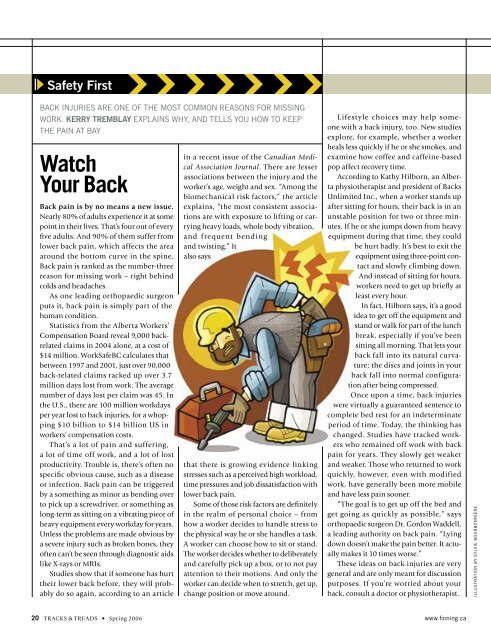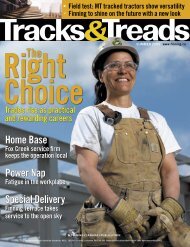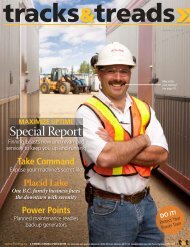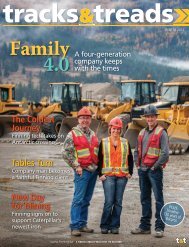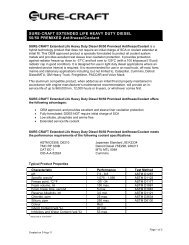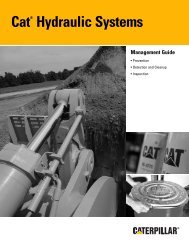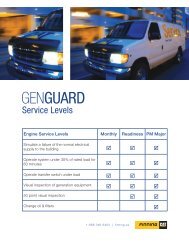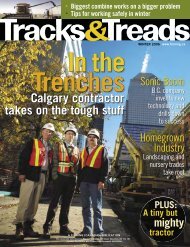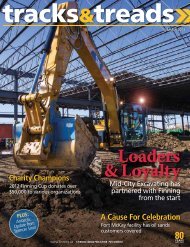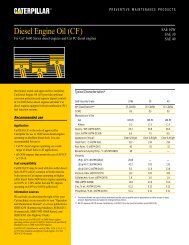Wanted Tour - Finning Canada
Wanted Tour - Finning Canada
Wanted Tour - Finning Canada
Create successful ePaper yourself
Turn your PDF publications into a flip-book with our unique Google optimized e-Paper software.
Safety FirstBACK INJURIES ARE ONE OF THE MOST COMMON REASONS FOR MISSINGWORK. KERRY TREMBLAY EXPLAINS WHY, AND TELLS YOU HOW TO KEEPTHE PAIN AT BAYWatchYour BackBack pain is by no means a new issue.Nearly 80% of adults experience it at somepoint in their lives. That’s four out of everyfive adults. And 90% of them suffer fromlower back pain, which affects the areaaround the bottom curve in the spine.Back pain is ranked as the number-threereason for missing work – right behindcolds and headaches.As one leading orthopaedic surgeonputs it, back pain is simply part of thehuman condition.Statistics from the Alberta Workers’Compensation Board reveal 9,000 backrelatedclaims in 2004 alone, at a cost of$14 million. WorkSafeBC calculates thatbetween 1997 and 2001, just over 90,000back-related claims racked up over 3.7million days lost from work. The averagenumber of days lost per claim was 45. Inthe U.S., there are 100 million workdaysper year lost to back injuries, for a whopping$10 billion to $14 billion US inworkers’ compensation costs.That’s a lot of pain and suffering,a lot of time off work, and a lot of lostproductivity. Trouble is, there’s often nospecific obvious cause, such as a diseaseor infection. Back pain can be triggeredby a something as minor as bending overto pick up a screwdriver, or something aslong-term as sitting on a vibrating piece ofheavy equipment every workday for years.Unless the problems are made obvious bya severe injury such as broken bones, theyoften can’t be seen through diagnostic aidslike X-rays or MRIs.Studies show that if someone has hurttheir lower back before, they will probablydo so again, according to an articlein a recent issue of the Canadian MedicalAssociation Journal. There are lesserassociations between the injury and theworker’s age, weight and sex. “Among thebiomechanical risk factors,” the articleexplains, “the most consistent associationsare with exposure to lifting or carryingheavy loads, whole body vibration,and frequent bendingand twisting.” Italso saysthat there is growing evidence linkingstresses such as a perceived high workload,time pressures and job dissatisfaction withlower back pain.Some of those risk factors are definitelyin the realm of personal choice – fromhow a worker decides to handle stress tothe physical way he or she handles a task.A worker can choose how to sit or stand.The worker decides whether to deliberatelyand carefully pick up a box, or to not payattention to their motions. And only theworker can decide when to stretch, get up,change position or move around.Lifestyle choices may help someonewith a back injury, too. New studiesexplore, for example, whether a workerheals less quickly if he or she smokes, andexamine how coffee and caffeine-basedpop affect recovery time.According to Kathy Hilborn, an Albertaphysiotherapist and president of BacksUnlimited Inc., when a worker stands upafter sitting for hours, their back is in anunstable position for two or three minutes.If he or she jumps down from heavyequipment during that time, they couldbe hurt badly. It’s best to exit theequipment using three-point contactand slowly climbing down.And instead of sitting for hours,workers need to get up briefly atleast every hour.In fact, Hilborn says, it’s a goodidea to get off the equipment andstand or walk for part of the lunchbreak, especially if you’ve beensitting all morning. That lets yourback fall into its natural curvature;the discs and joints in yourback fall into normal configurationafter being compressed.Once upon a time, back injurieswere virtually a guaranteed sentence tocomplete bed rest for an indeterminateperiod of time. Today, the thinking haschanged. Studies have tracked workerswho remained off work with backpain for years. They slowly get weakerand weaker. Those who returned to workquickly, however, even with modifiedwork, have generally been more mobileand have less pain sooner.“The goal is to get up off the bed andget going as quickly as possible,” saysorthopaedic surgeon Dr. Gordon Waddell,a leading authority on back pain. “Lyingdown doesn’t make the pain better. It actuallymakes it 10 times worse.”These ideas on back injuries are verygeneral and are only meant for discussionpurposes. If you’re worried about yourback, consult a doctor or physiotherapist.ILLUSTRATION BY SYLVIE BOURBONNIÈRE20 TRACKS & TREADS • Spring 2006 www.finning.ca


